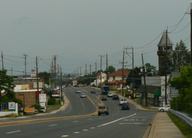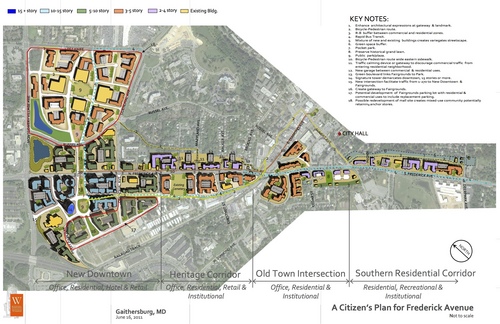Gaithersburg residents create own plan for smart growth
Filling a void of vision for a livable, sustainable future for Gaithersburg, my neighbors and I created our own plan for managing growth along the MD-355 corridor. It was met with great interest by City officials, who are trying to figure out what to do with it.
Along Montgomery County’s MD 355/Metro Red Line Corridor, a string of walkable town centers surrounding Metro stations is finally taking shape. But north of the Shady Grove Metro station, Gaithersburg is distinguished by its doughnut-shaped city plan.
Sprawling suburban office parks, with a few mixed-use “Town Centers” around the edge, are the doughnut, and the central MD 355/Frederick Avenue Corridor is the hole. The latter is a strip of gas stations, underused commercial centers and fast food restaurants in the midst of an ocean of asphalt. The road itself is a car-dominated commuter route with dominating power poles, insignificant sidewalks, and no quarter for bicyclists.
A new draft of the City’s Land Use Plan retains this vision. Yet if the smart growth planned for the Red Line corridor is to extend through Gaithersburg, the Frederick Avenue Corridor is where it must go. Like the Corridor through Bethesda and Rockville, Frederick Avenue is quite thickly hemmed in with older residential neighborhoods.
Any plan to urbanize the Corridor needed to pay close heed to the borders. Rather than just commenting on the inadequate city plan, my activist friend and neighbor Judy Christensen and I decided to work with our neighbors to prepare our own plan.
The neighbors responded. We organized three charrette meetings in spring 2011 with pro bono help from Scott Knudson of Wiencek and Associates, an architecture and planning firm with an office in the Corridor. Zoning lawyers representing some of the larger land and building owners in the Corridor also advised us.
The result, the Citizens’ Plan, exceeded my expectations. The plan embraces transit-oriented smart growth in the corridor, sometimes literally in peoples’ back yards. Residents want redevelopment of substandard buildings, better retail we can walk to, and Frederick Avenue rebuilt as a multi-use urban boulevard. We accept that considerable planned density is necessary to make all this financially feasible.
The Corridor needs more primary businesses and affluent residents to patronize the higher-end retailers. The Plan thus calls for medium-height mixed-use buildings along a narrow corridor with ground floor retail in a limited area. Greenways and alleys separate the Corridor development from the neighborhoods along the current borders between the two. Creative traffic calming is invoked to permit but discourage traffic on the residential side streets.
The highlight of the Citizens’ Plan is the New Downtown for Gaithersburg, a concept we resurrected from plans dating back to the 1960s. City officials didn’t want to sacrifice their historic Old Town for a major modern downtown, but they identified the perfect place for a New Downtown: about a mile north of Old Town, in the empty space at the intersection of Frederick with Quince Orchard Road/Montgomery Village Avenue. As happened at most of the County’s designated “corridor cities,” large-scale retail, including Lake Forest Mall, came to dominate the New Downtown, and the idea of a real downtown was forgotten.
But we liked the old plan and reinstalled the New Downtown in the Citizens’ Plan. The downtown core is west of Frederick Ave, where the tall buildings would be visible from miles away. The proposed Frederick Avenue Bus Rapid Transit line runs directly into the main public plaza.
The Citizens’ Plan seeks to inspire redevelopment of the Corridor in a way that protects and enhances the adjoining neighborhoods. It generated enthusiasm among the residents who worked on it. The draft plan was widely circulated through the neighborhood email lists; the only responses we got were positive, and even appreciative.
We presented the Citizens’ Plan to the Gaithersburg elected officials and Planning Commission in July. They were also enthusiastic, and instructed the planning staff to figure out how to incorporate our concepts into their official plan. We also had a discussion at a Planning Commission meeting in September.
While we were unable to do the broad public outreach and host the kind of extensive dialogue we envisioned, the Citizens’ Plan has already succeeded. Better than telling officials, we have shown them what a plan for smart growth looks like, and shown that the public will embrace such a plan if they are empowered to shape it to suit their needs.
To read the Citizens’ Plan, visit the City of Gaithersburg website and look through the list of Land Use Plan Exhibits for the Citizens’ Plan.



